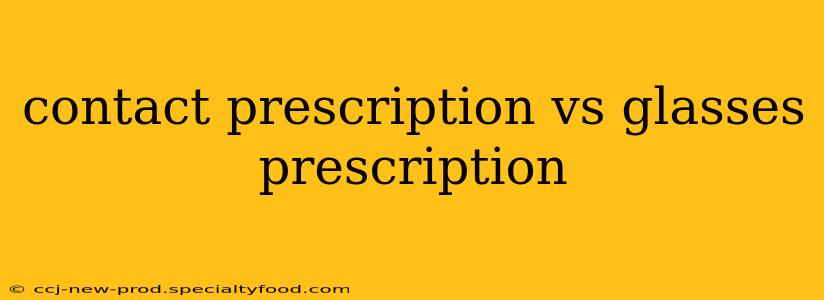Choosing between contact lenses and glasses often comes down to personal preference, lifestyle, and visual needs. But understanding the differences between contact and glasses prescriptions is crucial for ensuring clear and comfortable vision. While both correct refractive errors, the prescriptions themselves are subtly different, and using the wrong one can lead to blurry vision or eye strain.
What's in a Prescription?
Both glasses and contact lens prescriptions contain similar information, primarily focusing on the refractive errors needing correction:
- Sphere (SPH): This corrects for myopia (nearsightedness) or hyperopia (farsightedness). A negative number indicates myopia, while a positive number signifies hyperopia.
- Cylinder (CYL): This corrects for astigmatism, an imperfection in the eye's curvature causing blurred vision at all distances. A value of 0.00 indicates no astigmatism.
- Axis (AXIS): This value is only relevant if you have astigmatism. It indicates the orientation of the astigmatism in your eye.
- Add: This is usually only found in glasses prescriptions and relates to the added power for near vision (reading). It's crucial for progressive lenses (multifocal lenses).
- Pupillary Distance (PD): This measures the distance between the centers of your pupils. This is vital for glasses prescriptions to ensure proper alignment of the lenses.
Why Are Contact and Glasses Prescriptions Different?
The key difference lies in the location of the corrective lens. Glasses sit a distance from the eye, while contact lenses rest directly on the cornea. This distance affects how the light is refracted and, consequently, the prescription values.
Contact lenses correct for the refractive error at the corneal surface, while glasses prescriptions account for the distance between the lens and the eye. This means a direct conversion isn't possible; your eye doctor must perform separate measurements and calculations for each.
What if I Use the Wrong Prescription?
Using the wrong prescription, whether glasses for contacts or vice versa, can lead to several issues:
- Blurry vision: This is the most common consequence. The incorrect refractive power won't adequately correct your vision.
- Eye strain and headaches: Your eyes will work harder to compensate for the mismatch, leading to discomfort and headaches.
- Eye discomfort: Contact lenses are designed for direct corneal contact; using the wrong prescription could cause irritation, dryness, or even damage.
- Reduced visual acuity: Long-term use of the wrong prescription could potentially impact your vision's overall sharpness.
Can I Use My Glasses Prescription for Contacts?
No. Absolutely not. As explained above, the prescription needs to account for the lens's position relative to your eye. Using a glasses prescription for contacts, or vice versa, is dangerous and could harm your eyes.
How Often Should I Get My Eyes Checked?
Regular eye exams are vital for maintaining good vision and detecting potential problems early. The frequency depends on your age and individual needs, but generally, adults should have their eyes checked at least every one to two years. Children and those with existing eye conditions may require more frequent examinations.
What Does "Base Curve" Mean in a Contact Lens Prescription?
The base curve refers to the curvature of the contact lens. It's crucial for ensuring a comfortable and proper fit on the cornea. This is a parameter specific to contact lens prescriptions and not found in glasses prescriptions.
Do I Need a Separate Prescription for Each Type of Contact Lens?
Yes. Even if you're using the same brand and material of contact lens, the prescription might slightly vary depending on factors like lens type (daily, monthly, etc.) and the lens's material. Your eye doctor will determine the best fit for you.
In conclusion, while both glasses and contact lenses correct vision, their prescriptions are distinct due to the differing positions of the corrective lenses. Always consult your optometrist or ophthalmologist for accurate prescriptions tailored to your individual needs and chosen vision correction method. Never attempt to use one prescription for the other; it's crucial for both your vision health and comfort.
